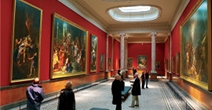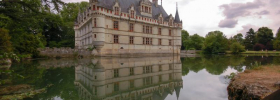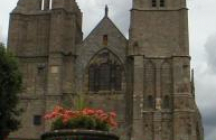 Home
Home- > Monuments France
- > Bretagne
- > Ille-et-Vilaine
- > Dol-de-bretagne
- > Cathédrale saint-samson
Cathédrale Saint-Samson
The Cathedral of St. Samson of Dol de Bretagne is a former Roman Catholic cathedral dedicated to Saint Samson and Gothic. It is an important French historical monument, located at Dol de Bretagne in the department of Ille-et-Vilaine. It was the seat of the bishopric of Dol-de-Bretagne since the year 555, one of nine ancient bishoprics of Brittany. During the revolution, the cathedral became successively Temple of Reason, stable and warehouse. Upon restoration of the religious function, Dol does not regained his title of bishop. It was indeed suppressed by the Concordat of 1801, and its territory divided between the dioceses of Rennes and Saint-Brieuc.
The cathedral of Saint-Samson is the subject of a classification as a historic monument by the list of 1840. It's in 548 that St Samson, Bishop monk Cardiff, Wales, arrived at Dol and founded a monastery. Soon after, in 555, Judual king of Britain, transformed the monastery into a bishopric. After the coronation of Nominoë, ruler of the Britons, in 848, the city became the religious capital of Brittany. Soon a pre-Romanesque cathedral replaces the original church, but it was destroyed by the Vikings in 1014. A Romanesque cathedral was then built. In the middle of the eleventh century Pope Gregory VII, an archbishop dedicated to Dol de Bretagne, but the kings of France are opposed and the Archbishop of Tours, so that by 1199, the Pope decides to delete Archbishopric of Dol and Breton bishoprics back under the jurisdiction of the archdiocese of Tours. In 1203, King John Lackland of England fire the Romanesque cathedral. Fearing for his soul, he will help finance its reconstruction, which starts in September the same year under the leadership of Bishop John VII Lizaunet. In 1231, the death of John Lizaunet the nave was completed. His successor Clement de Vitre (also called Clement of Coetquen or Coetquin) built the transept and choir with flat bed. The relics of St. Samson attract many pilgrims, which requires the construction of an ambulatory. Bishop Clement of Vitre take on the job site laborers who worked in the building of cathedrals and other new techniques introduced.
The new construction is done on the basis of the Romanesque sanctuary above, but in the Gothic style called Anglo-Norman and continues throughout the thirteenth century. Last stage, the choir with its ambulatory and ten side chapels, was completed in 1279. The cathedral is now operational, but does not yet have its gothic towers. The large south porch, located at the end of the south transept, will be added in the fourteenth and fifteenth centuries. At the same time, be constructed on both sides of the latter, to the west, the chapter house, to the treasure. During the same year the building was held in very high axial chapel of the apse.
Accommodation nearby
Latest news onCathédrale Saint-Samson
Tourism near
 Visit the city of Dol-de-bretagne
Visit the city of Dol-de-bretagne - 4 Museum
- 6 Monuments
Tours
 Travel trip to discover Britttany
Travel trip to discover Britttany
 The 'Pays de la baie'
The 'Pays de la baie'
 Dol-de-Bretagne
Dol-de-Bretagne
 Cancale
Cancale





































